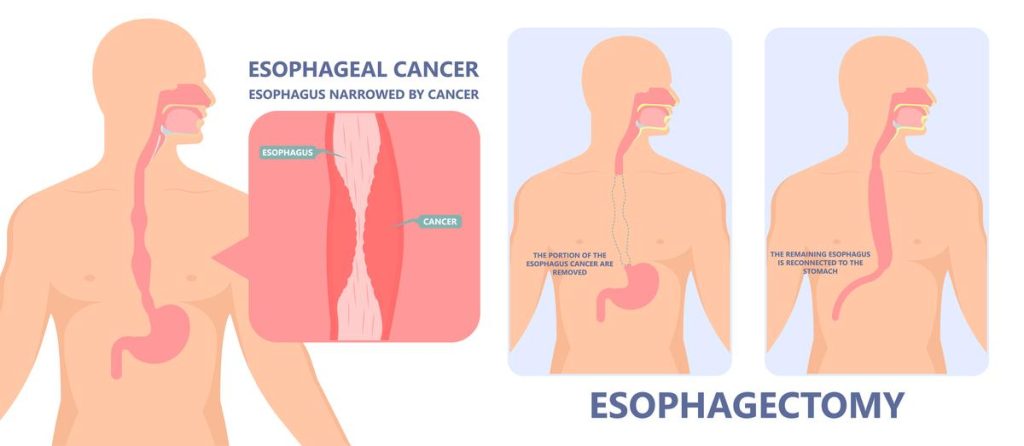Esophagectomy
An esophagectomy is a medical procedure conducted to eliminate a section or the entirety of the esophagus, which is the passage through which food travels from the throat to the stomach. This surgery is mainly carried out to treat esophageal cancer. The various types of esophagectomy and the specifics of the operation are thoroughly explained.

Why the Procedure Is Performed
In order to address certain medical conditions, it is possible to undergo a surgical procedure aimed at eliminating the lower part of the esophagus.
- Achalasia refers to a disorder in which the muscular ring in the esophagus does not function properly.
- Barrett’s esophagus is a condition where the lining of the esophagus becomes significantly damaged, potentially leading to the development of cancer.
- Severe trauma
- Destroyed esophagus
- Severely damaged stomach
Esophagectomy Types
Your Penn surgical team will most probably employ minimally invasive methods such as laparoscopy to perform the esophagectomy and remove the cancer along with nearby lymph nodes. Laparoscopy involves multiple small incisions, which are expected to result in reduced pain and a quicker recovery compared to traditional open esophageal surgery. Afterwards, a pathologist specialized in gastrointestinal cancers will carefully examine your lymph nodes to determine if the cancer has spread.
The type of surgery you undergo depends on where the tumor is located in your esophagus. We have three options for esophagectomies.

Transhiatal Esophagectomy
The most frequently performed surgery for esophageal cancer is called transhiatal esophagectomy, which requires only an incision in the neck.
During a transhiatal esophagectomy, we:
- Surgically eliminate a large portion of your esophagus along with a small section of your stomach.
- Elevate the lower part of your stomach towards your throat and connect it to the remaining portion of the esophagus.
Ivor Lewis Esophagectomy
The Ivor Lewis procedure is the second most frequently conducted esophagectomy. This method requires making cuts in both the abdomen and chest. Throughout this surgery, we:
- Remove part of your esophagus
- Create a passageway or channel using a section of the stomach.
- Attach the stomach tube to the esophagus in the chest.
Thoracoabdominal Gastrectomy
The thoracoabdominal approach is not frequently used, but it is employed when there is a tumor located in the lower esophagus or at the junction where the esophagus meets the stomach.
During this procedure, we:
- Create a cut in your abdominal area extending towards the left part of your chest.
- Divide your esophagus in the left chest
- To establish a fresh link, position either your stomach or small intestine against your left chest.
What happens during an esophagectomy?
Before the operation, the patient undergoes anesthesia to induce sleep. Additionally, the medical team may insert an epidural catheter into the patient’s back before they fall asleep, which assists in managing pain after the surgery.
- The amount of the esophagus and a usually smaller part of the stomach are surgically removed by the surgeon, depending on where the tumor is located and the method they use for the surgery.
- After that, the doctor will join the remaining esophagus to the stomach, which will be moved up to either the chest or neck region, depending on the type of esophagectomy.
- The surgeon will eliminate lymph nodes as well to analyze them for the presence of cancer. Lymph nodes, which are oval-shaped structures that filter lymph or extracellular fluid, are an integral part of the body’s immune system. If cancer is detected in these lymph nodes, it indicates that the cancer has extended beyond the esophagus.

After the Procedure
Typically, individuals remain hospitalized for a duration of 7 to 14 days following this procedure. Immediately after the surgery, it is common to spend a span of 1 to 3 days in the intensive care unit (ICU).
During your hospital stay, you will:
- You will be requested to gently move from your bed to a seated position and take a few steps on the same day or the day following the surgical procedure.
- After undergoing surgery, you will not be able to consume any food for a minimum of 5 to 7 days. Following this period, you may gradually introduce liquids into your diet. During this time, your nourishment will be delivered through a feeding tube that was inserted into your intestine during the surgery.
- In order to remove accumulated fluids, there is a need for a tube to be inserted into one’s chest.
- In order to prevent blood clots, it is recommended to wear specialized stockings on your feet and legs.
- Receive shots to prevent blood clots.
- You have the option to either receive pain medication intravenously or orally. If you choose a special pump, you can press a button to administer the medication as needed, giving you control over the dosage.
- Practice respiratory exercises to reduce the risk of developing lung infections.
Once you have returned home, make sure to adhere to the instructions provided to take care of yourself during the healing process. In particular, pay attention to the guidance on your diet and eating habits, ensuring that you follow them accordingly.
Esophagectomy Recovery
After undergoing surgery, it will not be possible for you to consume food or beverages. Instead, you will have to rely on a tube for feeding purposes for a period of 4-6 weeks, or until your complete recovery. During this process, the nourishment will travel through a slender tube inserted into your abdomen, which then links to your small intestine.
Treatment in Türkiye:
The medical staff of surgical teams, doctors and consultants in Rehab Türk can provide the best treatment options and free consultations – by striving to keep abreast of the latest medical technologies and methods.

